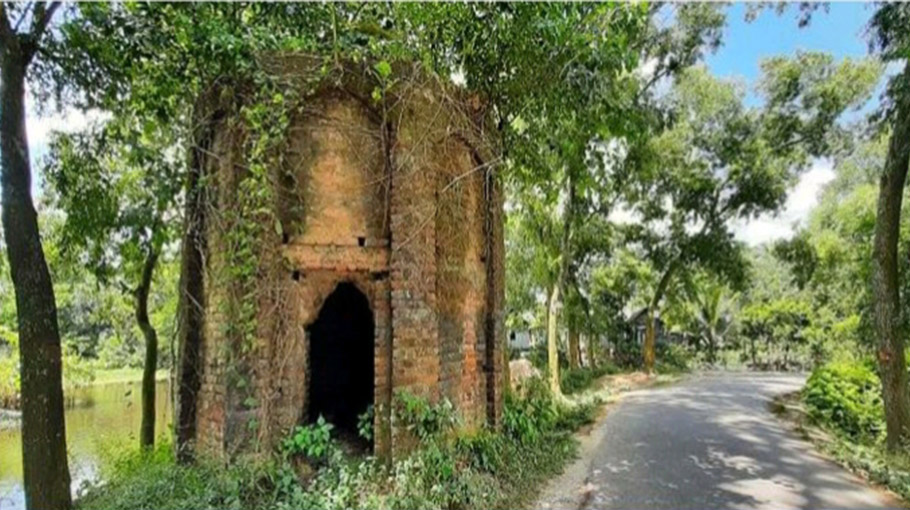300 years’ old ‘Satidaha’ temple in dilapidated state, conservation needed

In the name of reform, the upazila administration has changed the original form of the 300-year-old temple called ‘Satidaha Mandir’ of Brahmanbaria's Nabinagar upazila.
The temple is located 15 km east of Nabinagar Upazila Sadar at the southern end of Vidyakut village.
According to local residents and folk culture researchers, the Nabinagar upazila administration recently took initiative to restore the temple which was damaged during the Liberation War. In this case, the temple was cleaned and whitewashed without any consultation with the Department of Archaeology.
They say, due to this renovation, the temple has lost its original form.
According to the Department of Archeology, the temple is not listed by the Department. Those who undertook the reform did not do it properly. Because no ancient archetype can be changed in the name of reform.
Sati was an inhuman practice of forcing a newly widowed Hindu woman to commit suicide on her husband's pyre. Basically, this practice was social and religious murder. Relatives of the dead would force the newly widowed woman to be burnt on her husband's pyre in order to take possession of the deceased's property and for fear of ruining the family honor.
Raja Rammohan Roy started a social movement against sati-immolation in 1812. When Lord William Bentinck became the Governor of Bengal in 1828, Rammohan Roy appealed to him to ban the practice of sati-immolation. Later on December 4, 1829, Lord Bentinck passed a law declaring the practice of Sati as a prohibited and punishable crime.
According to the information given in the Brahmanbaria district information database, Dewan Ram Manik, a resident of the famous Hindu Zamindar Dewan house of Vidyakut village, built the temple.
According to Brahmanbaria folklore researcher Zahirul Islam Chowdhury Swapan, the ‘Satidaha temple’ in Vidyakut village is more than 300 years old. Around 1980, he collected a letter from the British government from Banalata Devi, a housewife in the village. In that letter sent to the then King of Tripura, there was an order to stop the practice of sati immolation.
Swapan told The Daily Bangladesh Post, 'Usually the archeology department preserves 100-year-old structures. But it has not yet been listed as an antiquities.'
Commenting that the temple is intertwined with the history, tradition and existence of the area, this researcher said, 'Due to unplanned renovation without understanding, the original form and historical importance of this valuable monument has been lost.'
When asked about this, director of Cumilla regional office of Directorate of Archeology AKM Saifur Rahman told Daily Bangladesh Post, 'The temple is not listed by the Directorate. I did not even know about it. I will see if the building can be listed as a monument.'
When asked why it has not been listed by the Directorate of Archeology, he said, there is a shortage of manpower in the office. The survey work on the archaeological resources of Brahmanbaria district has not been completed yet. This work is time consuming and requires skilled manpower to do it.
This official said that the District Council Act has said to preserve antiquities locally. They could save it too. Why they haven't done it till today, they can tell.
In response to the question whether such an ancient structure can be renovated in this way or not, he said, 'Those who did this did not decide. Because the original form of this establishment cannot be changed.
Those who did the painting, should have contacted the Department of Archeology for advice and technical assistance.'
Chanaullah, a resident of Vidyakut village and a former UP member, said that the family who built the temple left the country long ago. But the temple is still standing. For a long time it was covered with weeds.
Kavi Jaidul Hossain, president of Brahmanbaria Sahitya Academy, thinks, 'This ancient temple needs to be preserved to inform the future generations about the black chapter of sati-dah practice.'
Billal Mia Chowdhury, the head teacher of Vidyakut Amar Bahumukhi High School, a century-old educational institution of the village, said, "Raja Rammohan Roy showed the light path of the Hindus from the dark path of bigotry, misogyny, superstition and medieval barbarism by abolishing the practice of satidah." To inform the new generation about that era, this pattern must be preserved.
Nabinagar Upazila Executive Officer (UNO) Mohammad Ekramul Siddique said, 'Once this temple was full of weeds. About a year and a half ago, the former chairman of Vidyakut, Enamul Haque, took the initiative on behalf of the Union Parishad and painted it in red and white colors and put up a signboard.
The then upazila administration allocated money for lime work of this Satidaha temple.



